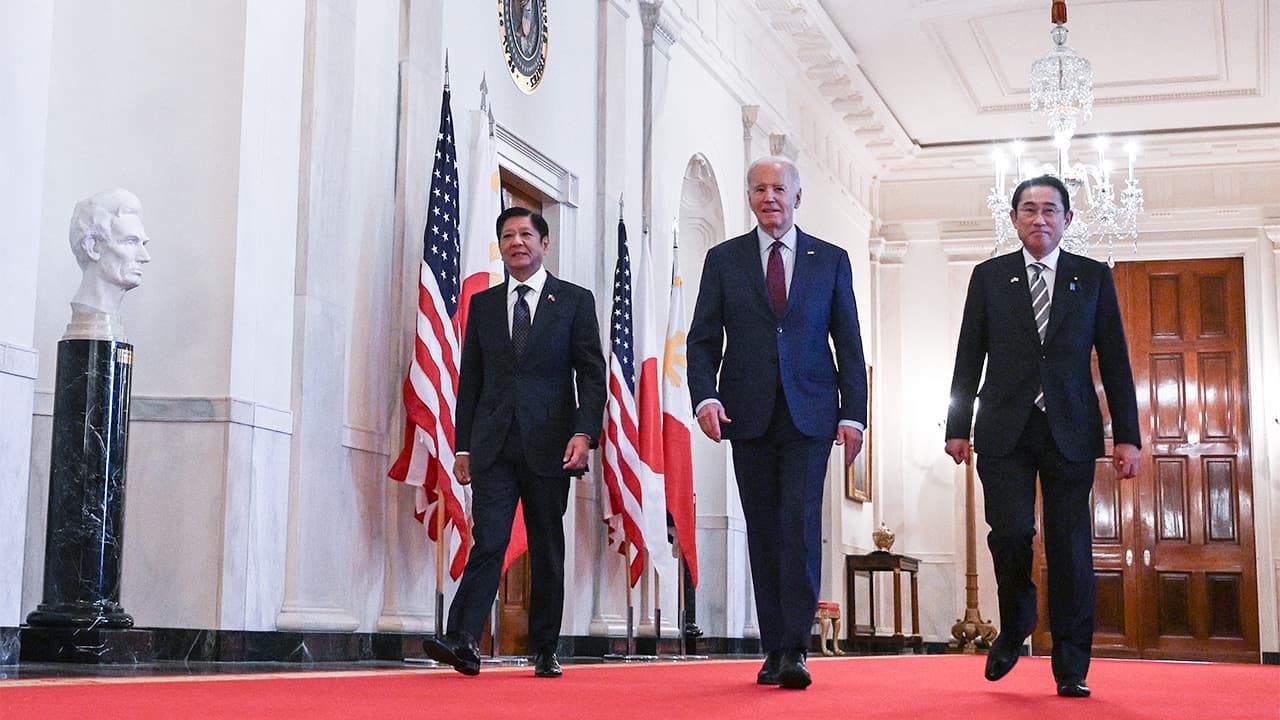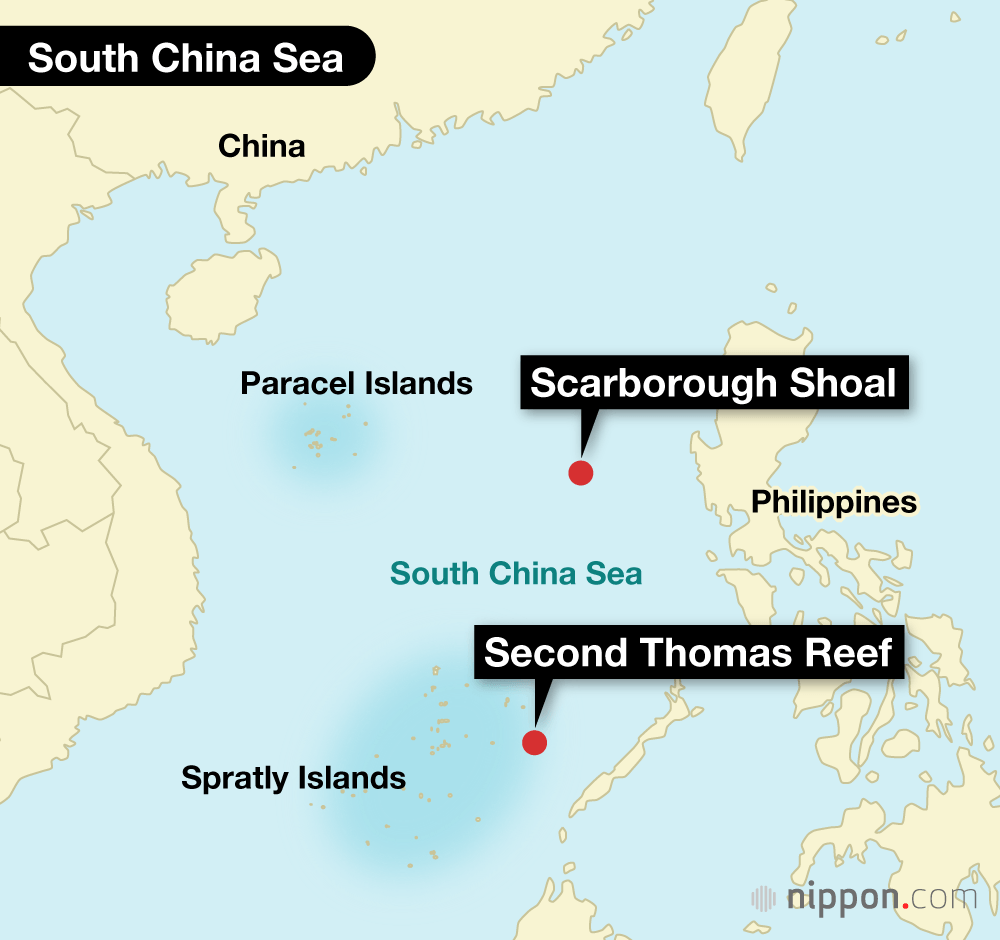
Pushing Back Against China: US-Japan-Philippine Trilateral Cooperation in the South China Sea
Politics- English
- 日本語
- 简体字
- 繁體字
- Français
- Español
- العربية
- Русский
China’s Hardline Stance
Going back to the 1970s, China’s actions in the South China Sea have been a continual source of antagonism for the Philippines, Vietnam, Malaysia, and other regional nations. Such actions have included the actual or threatened use of military force to assert China’s territorial and maritime interests over the Spratly Islands and the Paracel Islands—which are also claimed by other Southeast Asian nations. For example, in 2012, China used maritime law enforcement vessels to wrest control of Scarborough Shoal from the Philippines. China then continued to strengthen its South China Sea presence by converting minor geographical features into artificial islands. These artificial islands were soon converted into military bases. Beijing has also enhanced the activities of Chinese Coast Guard vessels and supported the activities of Chinese maritime militias in the area.
Beginning in February 2023, China has engaged in a concerted effort to use force against the Philippines in an attempt to effect a change in the status quo over the Spratly Islands’ Second Thomas Reef. The Philippines currently controls the reef through the stationing of marines on the BRP Sierra Madre, a navy transport ship intentionally grounded there in 1999. In the February incident, a China Coast Guard vessel directed a powerful military-grade laser at the crew of the Sierra Madre, temporarily blinding some of its crew. The Chinese vessel also engaged in dangerous maneuvers that hindered a Philippine Coast Guard patrol vessel’s attempt to resupply the marines on the Sierra Madre.
The provocations continued. In August, China Coast Guard vessels directed water cannons against another Philippine patrol vessel attempting to supply provision the Second Thomas Reef. This was followed by CCG vessels colliding with Philippine supply ships in October in the same waters. Then in March 2024, a collision between Chinese and Philippine Coast Guard vessels resulted in serious damage to the Philippine vessel and injuries to its crew. Later in the month, the use of a water cannon also resulted in damage to a Philippine ship and injuries to crew members.

A China Coast Guard ship rapidly approaches a Philippine Coast Guard ship (foreground) near Second Thomas Reef in the South China Sea on June 30, 2023. (Courtesy of the Philippine Coast Guard; © Jiji)
President Marcos’ Policy Shift as an Opportunity?
One reason for China’s newly aggressive South China Sea actions against the Philippines is the policy shift by President Ferdinand Marcos Jr. Marcos, who took office in June 2022, signaled a different diplomatic direction from his predecessor, President Rodrigo Duterte. Duterte was neither afraid of engaging China nor confronting the United States when it suited his purposes. For example, despite the July 2016 decision by the International Court of Arbitration that ruled in favor of the Philippines and flatly rejected China’s South China Sea claims, Duterte was rather lukewarm in urging China to comply with the decision. Instead, Duterte visited Beijing to meet with President Xi Jinping and secure a promise of significant support for Philippine infrastructure development. On the other hand, Duterte caused alliance tensions by suspending or curtailing joint training between Philippine and American forces and at one stage even giving notice that he was terminating the Philippines’ Visiting Forces Agreement with the United States—a notice he later retracted.
By contrast, President Marcos made it clear that he would make no concessions to China regarding the Philippines’ sovereignty. He clearly demanded that China comply with the 2016 arbitral award and set about consolidating the US-Philippine alliance. During his visit to the United States in September 2022, President Marcos and US President Joe Biden also reaffirmed the importance of the United States–Philippines Mutual Defense Treaty. When US Secretary of Defense Lloyd Austin visited Manila in February 2023, both sides agreed on the use of four further bases by American forces—including one close to Taiwan—in addition to the five bases agreed upon for use in the 2014 Enhanced Defense Cooperation Agreement. An expansion of the scale of joint exercises between American and Philippine forces, beginning with the already instituted “Exercise Balikatan,” signaled further strengthening of defense cooperation between Washington and Manila.
The Chinese government, however, cites the Marcos administration’s failure to abide by “agreements” made between the Duterte administration and Beijing as the reason for China Coast Guard vessels inhibiting the passage of Philippine ships supplying the Second Thomas Reef. The Chinese side claims such an agreement included a commitment by Manila to limit supplies to the reef to water and food. In Beijing’s telling, as long as the Philippines did not bring in materials needed to repair or reinforce the facility, Chinese government vessels would tacitly allow the Philippines to continue resupply missions. China claims that the Marcos administration’s subsequent provisioning of construction materials and other supplies justifies its interference with the supply ships. The Marcos administration, on the other hand, claims that it is not aware of the existence of any “agreement” with China and would refuse to recognize it even if it did exist.
Needless to say, even if such commitments were made by Duterte, the lack of a formal, written agreement means the Marcos administration is not bound by such a policy. By using this so-called “agreement” as pretext for a hardline response in the South China Sea, China is clearly using force to coerce the Marcos administration to revert to the Duterte administration’s softer policy on the South China Sea issue.
Strengthened Security Cooperation for Manila
Beijing’s attempts to effect a change in Manila’s policy through pressure have yielded little success; indeed, they appear to have had the opposite effect. The Marcos administration is not only refusing to accept China’s South China Sea demands but is crafting a more robust response by strengthening security cooperation with both Japan and the United States to pushback against China.
In April 2024, the first-ever US-Japan-Philippine leaders’ summit was held on the occasion of Japanese Prime Minister Kishida Fumio’s official visit to the United States to meet with President Biden. Joined by President Marcos, the three leaders announced a “Joint Vision Statement” that emphasized “proud and resolute commitment” to shared, “fundamental values of freedom, democracy, respect for human rights, and the rule of law.” The statement also asserted that the three countries were “united by the vision we share of a free and open Indo-Pacific and international order based on international law.”
The Joint Vision Statement also contained direct and harsh criticism of China’s “dangerous and aggressive behavior in the South China Sea.” The three leaders expressed their opposition to “the dangerous and coercive use of Coast Guard and maritime militia vessels in the South China Sea, as well as efforts to disrupt other countries’ offshore resource exploitation.” The statement also reiterates concerns about Beijing’s use of Coast Guard vessels for “repeated obstruction of Philippine vessels’ exercise of high seas freedom of navigation and the disruption of supply lines to Second Thomas Shoal, which constitute dangerous and destabilizing conduct.” The tone of the statement indicates that the three sides have agreed to jointly oppose aggressive actions by Chinese maritime patrol vessels and maritime militias.
The three countries also clarified specifics of enhanced approaches to maritime security cooperation. In 2023, the coast guard organizations of the United States, Japan, and the Philippines conducted their first ever joint training exercises. This cooperation will be taken up a notch in 2024 when Japanese and Philippine coast guard officers board a US Coast Guard patrol vessel during a patrol in the Indo-Pacific. There are also plans for an “at-sea trilateral exercise” and other activities “to improve interoperability and advance maritime security and safety” in the Indo-Pacific, as well as a joint training activity around Japan.
Trilateral defense cooperation will also be advanced through American and Japanese support for the Philippines’ defense modernization priorities. Clearly, Japan and the United States are not only diplomatically supportive of the Philippines as it pushes back against Chinese intimidation but are committed to implementing concrete support measures that will enhance Manila’s own maritime law enforcement and defense capabilities.
Facing an Intransigent China
China strongly rejected the trilateral Joint Vision Statement. Liu Jinsong, director general of the Department of Asian Affairs of the Chinese Foreign Ministry, summoned Akira Yokochi, chief minister of the Embassy of Japan in Beijing, to lodge a protest and express “strong dissatisfaction” over the statement. Senior Colonel Wu Qian, a spokesperson for China’s Ministry of National Defense, also criticized the Philippines for involving outside parties and pretending that it was Manila that was being victimized. A commentary in the People’s Daily, the official newspaper of the Chinese Communist Party, labelled the trilateral meeting and resulting statement “a smear campaign” against China and warned that the attempt to create a “exclusive” small group would only pose a serious risk to regional stability.
Beijing’s strong opposition is an indication that the Chinese government is wary of security cooperation among the United States, Japan, and the Philippines posing a major obstacle to the pursuit of its South China Sea interests. In other words, efforts toward the realization of a free and open Indo-Pacific and enhanced trilateral cooperation will enhance deterrence against China’s attempts to use force to change the status quo in the South China Sea.
Together with the United States, Japan should work to maintain the rule of law in the South China Sea by supporting the Philippines, which is particularly vulnerable to Chinese pressure. If the status quo in the South China Sea is undermined through the use of force and the rule of law is negated, the adverse effects will inevitably spread and undermine the situations in the East China Sea, the Taiwan Strait, and the Indian Ocean. Maintaining stability in the South China Sea by strengthening security cooperation between the United States, Japan, and the Philippines, is therefore essential for the realization of a free and open Indo-Pacific region.
(Originally written in Japanese. Banner photo: From left, Philippine President Marcos, US President Biden, and Japanese Prime Minister Kishida attend the US-Japan-Philippines summit meeting at the White House, April 11, 2024. © AFP/Jiji.)
Related Tags
China United States Maritime security South China Sea Philippines

